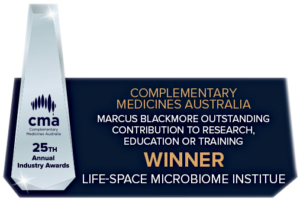Antimicrobial resistance (AMR) occurs when certain microbes, such as bacteria, viruses, fungi and parasites, evolve over time and no longer respond to antimicrobial medicines.(1) As a result, infections can persist in the body, increasing the risk of spread to others, severe illness and death. Microorganisms that develop antimicrobial resistance are sometimes referred to as “superbugs”. Examples include methicillin-resistant Staphylococcus aureus (MRSA) and vancomycin-resistant Enterococcus (VRE).(2)
Are we over-prescribing antibiotics?
One of the leading contributors to anti-microbial resistance has been the rise in exposure to antibiotic medications. Australia is one of the highest users of antibiotics in the developed world, which has largely been attributed to inappropriate prescribing. According to recent data, approximately 44-49% of Australian infants, children, and adults, are prescribed at least one antibiotic in a given year, with broad spectrum antibiotics being the most common types.(3,4)
Table 1: Estimate of combined daily doses per 1000 inhabitants for countries identified as similar to Australia, by year 3
Antibiotic ‘scarring’ and the need for improved stewardship
Antibiotics are life-saving medications; however, the non-specificity of their actions can result in acute and persistent changes in the host microbiome, sometimes referred to as ‘antibiotic scarring’.(5) Consequences of antibiotic-microbiome interactions include a reduction in diversity and the opportunistic growth of pathogens, increasing serious short-term risks, such as Clostridium difficile infection (CDI), and long-term risks such as immune or metabolic dysfunction.(6)
Another significant threat to microbiome health and composition is the rise of antibiotic resistance (AR). The global pool of AR bacteria are considered one of the greatest health and sustainability concerns of the 21st century, contributing to hundreds of thousands of human deaths per year while simultaneously increasing food security risk.(7) There is an irony in the reality that the effectiveness of antibiotic therapy has ultimately led to its decline in efficacy, in part due to years of misuse and over-use in both human health, agricultural and aquacultural settings.(8)
Probiotics as antimicrobials – a promising approach
Probiotics are defined as live microorganisms that, when administered in adequate amounts, confer a health benefit on the host. Probiotics can consist of live bacteria, fungi or yeasts, and have shown to exert various health benefits via the following actions;
• Digestion of foods
• Synthesis of nutrients and metabolites
• Pathogen control
• Adipose storage efficiency
• Immune development, modulation, and maturation
• Maintenance of gut barrier integrity
When it comes to antimicrobial resistance, the immune modulating actions of probiotics are of particularly interest. For instance, certain species and strains of probiotic bacteria have demonstrated the ability to produce antimicrobial peptides (AMPs) with broad spectrum activity against a wide range of pathogens. Also referred to as bacteriocins, AMPs can inhibit bacterial growth, disrupting biofilm formation and/or interfering with quorum sensing.(9)
Several clinical trials have confirmed benefits of probiotics in the treatment of pathogenic conditions, including bacterial vaginosis, vulvovaginal candidiasis, upper respiratory infections, H. pylori infection and Clostridium difficile-induced diarrhoea, as either stand-alone or adjunctive treatments.(10,11,12) Through reducing recurrence, incidence or symptoms of these conditions, probiotics may in turn reduce dependence on antibiotic therapy. This is particularly relevant for upper respiratory infections which account for 1/5 antibiotic prescriptions in Australia.(4)
Where to next?
Given the available evidence, the question arises as to whether antibiotic stewardship should include improved education on probiotic best-practice. According to a 2018 survey including 1066 HCPs from over 30 countries, over 79% of HCPs admitted to recommending probiotics to their patients, yet most HCPs also self-rated their probiotic knowledge as medium (36.4%).(13)
In conclusion, evidence suggests that probiotics are a safe and effective immune-modulating therapy that can be used as part of a multi-dimensional approach to tackle the rise in antimicrobial resistance. Improved access to education in probiotic best-practice is required to increase HCP knowledge and therefore confidence in probiotic prescribing.
References
[1] World Health Organization. Antimicrobial resistance [Internet].2023. [Cited 20th November 2023]. Available from https://www.who.int/health-topics/antimicrobial-resistance
[2] Jain M, Stitt G, Son L, Enioutina EY. Probiotics and Their Bioproducts: A Promising Approach for Targeting Methicillin-Resistant Staphylococcus aureus and Vancomycin-Resistant Enterococcus. Microorganisms. 2023; 11(10):2393. https://doi.org/10.3390/microorganisms11102393
[3] Anderson, H., Vuillermin, P., Jachno, K., Allen, K.J., Tang, M.L., Collier, F., Kemp, A., Ponsonby, A.L., Burgner D., and Barwon infant Study Investigator Group, 2017. Prevalence and determinants of antibiotics exposure in infants: A population-derived Australian birth cohort study. Journal of pediatrics and child health, 52(10). Pp.942-949
[4] NPS Medicinewise. Reducing Antibiotic Resistance 2012-2017 [internet]. NSW (AU). NPD Medicinewise (2018, cited May 2023). Available from: https://www.nps.org.au/assets/NPS/pdf/NPS-MedicineWise-Economic-evaluation-report-Reducing-Antibiotic-Resistance-2012-17.pdf
[5] Anthony WE, Wang B, Sukhum KV, D’Souza AW, Hink T, Cass C, Seiler S, Reske KA, Coon C, Dubberke ER, Burnham CA. Acute and persistent effects of commonly used antibiotics on the gut microbiome and resistome in healthy adults. Cell reports. 2022 Apr 12;39(2).
[6] Konstantinidis T, Tsigalou C, Karvelas A, Stavropoulou E, Voidarou C, Bezirtzoglou E. Effects of antibiotics upon the gut microbiome: a review of the literature. Biomedicines. 2020 Nov;8(11):502.
[7] Jørgensen PS, Wernli D, Folke C, Carroll SP. Changing antibiotic resistance: sustainability transformation to a pro-microbial planet. Current Opinion in Environmental Sustainability. 2017 Apr 1;25:66-76.
[8] Dyar OJ, Obua C, Chandy S, Xiao Y, Stålsby Lundborg C, Pulcini C. Using antibiotics responsibly: are we there yet?. Future microbiology. 2016 Aug;11(8):1057-71.
[9] Jain M, Stitt G, Son L, Enioutina EY. Probiotics and Their Bioproducts: A Promising Approach for Targeting Methicillin-Resistant Staphylococcus aureus and Vancomycin-Resistant Enterococcus. Microorganisms. 2023 Sep 25;11(10):2393.
[10] Jeng HS, Yan TR, Chen JY. Treating vaginitis with probiotics in non‑pregnant females: A systematic review and meta‑analysis. Experimental and Therapeutic Medicine. 2020 Oct 1;20(4):3749-65.
[11] Shi X, Zhang J, Mo L, Shi J, Qin M, Huang X. Efficacy and safety of probiotics in eradicating Helicobacter pylori: A network meta-analysis. Medicine. 2019 Apr;98(15).
[12] Zhao Y, Dong BR, Hao Q. Probiotics for preventing acute upper respiratory tract infections. Cochrane database of systematic reviews. 2022(8).
[13] Fijan S, Frauwallner A, Varga L, Langerholc T, Rogelj I, Lorber M, Lewis P, Povalej Bržan P. Health professionals’ knowledge of probiotics: an international survey. International journal of environmental research and public health. 2019 Sep;16(17):3128.
